Effect of Withdrawal Rate on Solidification Microstructures of DD9 Single Crystal Turbine Blade
Abstract
:1. Introduction
2. Experimental
3. Results and Discussion
3.1. Dendrite Morphologies
3.2. Sizes and Morphologies of the γ′ Precipitates
3.3. Sizes and Morphologies of the γ-γ′ Eutectics
4. Conclusions
- With the increase of withdrawal rates, the dendrite morphologies tended to become more refined, and the secondary dendritic arms tended to be highly developed. Additionally, the dendrite in the blade aerofoil section was more refined than that in the tenon section, given the same withdrawal rate.
- The size and dispersity of the γ′ precipitates in the inter-dendritic regions and the dendritic core tended to decrease with increasing withdrawal rates. Moreover, the size distributions of the γ′ precipitates followed a normal distribution law. Compared with the inter-dendritic regions, the dendritic core exhibited a 62% reduction in the average γ′ size. Meanwhile, within the same withdrawal rate, the γ′ sizes in the aerofoil section were more refined than those in the tenon section. The increasing withdrawal rates resulted in a significant decrease in the γ′ sizes compared to the decreasing cross-sectional areas.
- The sizes of the γ–γ′ eutectics decreased with increasing withdrawal rates, and the morphologies of the γ–γ′ eutectics exhibited both lamellar and rosette shapes.
Author Contributions
Funding
Institutional Review Board Statement
Informed Consent Statement
Data Availability Statement
Conflicts of Interest
References
- Li, J.R.; Liu, S.Z.; Wang, X.G.; Shi, Z.X.; Zhao, J.Q. Development of a low-cost third generation single crystal superalloy DD9. In Superalloys 2016; Hardy, M., Huron, E., Glatzel, U., Griffin, B., Lewis, B., Rae, C., Seetharaman, V., Tin, S., Eds.; The Minerals, Metals & Materials Society: Warrendale, PA, USA, 2016; pp. 57–63. [Google Scholar]
- Li, J.R.; Zhong, Z.G.; Tang, D.Z.; Liu, S.Z.; Wei, P.; Wei, P.Y.; Wu, Z.T.; Huang, D.; Han, M. A low-cost second generation single crystal superalloy DD6. In Superalloys 2000; Pollock, T.M., Kissinger, R.D., Bowman, R.R., Green, K.A., McLean, M., Olson, S.L., Schirra, J.J., Eds.; The Minerals, Metals & Materials Society: Warrendale, PA, USA, 2000; pp. 777–783. [Google Scholar]
- Li, J.R.; Zhao, J.Q.; Liu, S.Z.; Han, M. Effects of low angle boundaries on the mechanical properties of single crystal superalloy DD6. In Superalloys 2008; Reed, R.C., Green, K.A., Caron, P., Gabb, T., Fahrmann, M.G., Huron, E.S., Woodard, S.A., Eds.; The Minerals, Metals & Materials Society: Warrendale, PA, USA, 2008; pp. 443–451. [Google Scholar]
- Krawczyk, J.; Bogdanowicz, W.; Sieniawski, J. Effect of blade geometry on γ′ lattice parameter and primary orientation of SX cored turbine blades (I). Materials 2023, 16, 112. [Google Scholar] [CrossRef] [PubMed]
- Rame, J.; Caron, P.; Locq, D.; Lavigne, O.; Mataveli Suave, L.; Jaquet, V.; Perrut, M.; Delautre, J.; Saboundji, A.; Guedou, J.Y. Development of AGAT, a third-generation nickel-based superalloy for single crystal turbine blade applications. In Superalloys 2020; Tin, S., Hardy, M., Clews, J., Cormier, J., Feng, Q., Marcin, J., O’Brien, C., Suzuki, A., Eds.; The Minerals, Metals & Materials Society: Warrendale, PA, USA, 2020; pp. 31–40. [Google Scholar]
- Shi, Z.X.; Wang, X.G.; Liu, S.Z.; Li, J.R. Rotary bending high cycle fatigue properties of DD9 single crystal superalloy at 800 °C. Mater. Mech. Eng. 2016, 40, 16–19. [Google Scholar]
- Shi, Z.X.; Li, J.R.; Liu, S.Z. Influence of withdrawal rate on tensile and stress rupture properties of the single crystal superalloy DD9. Mater. Sci. Forum. 2013, 747–748, 625–628. [Google Scholar] [CrossRef]
- Wang, X.G.; Li, J.R.; Shi, Z.X.; Liu, S.Z. Effect of solid solution heat treatment on microstructures of the third generation single crystal supperally DD9. Mater. Sci. Forum. 2013, 747–748, 549–558. [Google Scholar] [CrossRef]
- Wang, X.; Li, J.; Yu, J.; Liu, S.; Shi, Z.; Yue, X. Tensile anisotropy of single crystal superalloy DD9. Acta Metall. Sin. 2015, 51, 1253–1260. [Google Scholar]
- Yang, W.P.; Li, J.R.; Liu, S.Z.; Shi, Z.X.; Zhao, J.Q.; Wang, X.G. Orientation dependence of transverse tensile properties of nickel-based third generation single crystal superalloy DD9 from 760 to 1100 °C. Trans. Nonferrous Met. Soc. China 2019, 29, 558–568. [Google Scholar] [CrossRef]
- Liu, L.; Huang, T.; Qu, M.; Liu, G.; Zhang, J.; Fu, H. High thermal gradient directional solidification and its application in the processing of nickel-based superalloys. J. Mater. Process. Technol. 2010, 210, 159–165. [Google Scholar] [CrossRef]
- Lian, Y.Y.; Li, D.C.; Zhang, K. A method for flattening the solidification front in directional solidification technology. J. Cryst. Growth 2015, 426, 186–197. [Google Scholar] [CrossRef]
- Zheng, H.; Chen, R.; Qin, G.; Li, X.; Su, Y.; Ding, H.; Guo, J.; Fu, H. Phase separation of AlCoCrFeNi2.1 eutectic high-entropy alloy during directional solidification and their effect on tensile properties. Intermetallics 2019, 113, 106569. [Google Scholar] [CrossRef]
- Ren, N.; Li, J.; Wang, B.; Zeng, L.; Xia, M.; Li, J. Design of variable withdrawal rate for superalloy single-crystal blade fabrication. Mater. Des. 2021, 198, 109347. [Google Scholar] [CrossRef]
- Peng, P.; Lu, L.; Liu, Z.; Xu, Y.; Zhang, X.; Ma, Z.; Zhang, H.; Guo, M.; Liu, L. Investigation on influence of Ta on microstructure evolution of directionally solidified Ni-based superalloys. J. Alloys Compd. 2022, 927, 167009. [Google Scholar] [CrossRef]
- Liu, K.; Wang, J.; Yang, Y.; Zhou, Y. Effect of cooling rate on carbides in directionally solidified nickel-based single crystal superalloy: X-ray tomography and U-net CNN quantification. J. Alloys Compd. 2021, 883, 160723. [Google Scholar] [CrossRef]
- Zhu, Z.; Basoalto, H.; Warnken, N.; Reed, R.C. A model for the creep deformation behaviour of nickel-based single crystal superalloys. Acta Mater. 2012, 60, 4888–4900. [Google Scholar] [CrossRef]
- Ma, A.; Dye, D.; Reed, R.C. A model for the creep deformation behaviour of single-crystal superalloy CMSX-4. Acta Mater. 2008, 56, 1657–1670. [Google Scholar] [CrossRef]
- Murakumo, T.; Kobayashi, T.; Koizumi, Y.; Harada, H. Creep behaviour of Ni-base single-crystal superalloys with various γ′ volume fraction. Acta Mater. 2004, 52, 3737–3744. [Google Scholar] [CrossRef]
- Mirak, A.; Fathi, M. Effects of solidification rate and heat treatment on microstructure characterization and hot tensile strength of single crystal CMSX-4 superalloy. Mater. Charact. 2022, 194, 112449. [Google Scholar] [CrossRef]
- Lu, F.; Lu, S.; Antonov, S.; Li, L.; He, S.; Hou, M.; Wang, D.; Zhang, J.; Feng, Q. Duration-affected creep behaviors of Ni-based single crystal superalloys with/without rhenium addition designed for IGT application. Mater. Sci. Eng. A 2023, 864, 144560. [Google Scholar] [CrossRef]
- Chen, J.; Chen, J.; Wang, Q.; Wu, Y.; Li, Q.; Xiao, C.; Li, S.; Wang, Y.; Hui, X. Enhanced creep resistance induced by minor Ti additions to a second generation nickel-based single crystal superalloy. Acta Mater. 2022, 232, 117938. [Google Scholar] [CrossRef]
- Wang, F.; Ma, D.X.; Zhang, J.; Bogner, S.; Bührig-Polaczek, A. A high thermal gradient directional solidification method for growing superalloy single crystals. J. Mater. Process. Technol. 2014, 214, 3112–3121. [Google Scholar] [CrossRef]
- Szeliga, D. Microstructure refinement of single crystal Ni-based superalloy by improvement of thermal radiation shielding in the industrial-scale Bridgman solidification process. Int. Commun. Heat Mass Transf. 2020, 118, 104868. [Google Scholar] [CrossRef]
- Huo, M.; Liu, L.; Yang, W.; Hu, S.; Sun, D.; Su, H.; Zhang, J.; Fu, H. Dendrite growth and defects formation with increasing withdrawal rates in the rejoined platforms of Ni-based single crystal single crystal alloys. Vacuum 2019, 161, 29–36. [Google Scholar] [CrossRef]
- Li, Y.; Liu, L.; Sun, D.; Yue, Q.; Huang, T.; Gan, B.; Zhang, J.; Fu, H. Quantitative analysis of withdrawal rate on stray grain formation in the platforms of a Ni-Based single crystal dummy blade. J. Alloys Compd. 2019, 773, 432–442. [Google Scholar] [CrossRef]
- Rezaei, M.; Kermanpur, A.; Sadeghi, F. Effects of withdrawal rate and starter block size on crystal orientation of a single crystal Ni-based single crystal alloy. J. Cryst. Growth 2018, 485, 19–27. [Google Scholar] [CrossRef]
- Wang, F.; Wu, Z.; Ma, D.; Bührig-Polaczek, A. Effect of directional solidification variables on the microstructures of single-crystal turbine blades of nickel-based superalloy. Adv Eng. Mater. 2017, 19, 1700297. [Google Scholar] [CrossRef]
- Zhao, X.; Liu, L.; Yu, Z.; Zhang, W.; Zhang, J.; Fu, H. Influence of directional solidification variables on the microstructure and crystal orientation of AM3 under high thermal gradient. J. Mater. Sci. 2010, 45, 6101–6107. [Google Scholar] [CrossRef]
- Liu, J.L.; Meng, J.; Yu, J.J.; Zhou, Y.Z.; Sun, X.F. Influence of solidification conditions and alloying elements Re and Ti on micropores formed during homogenization of Ni base single crystal superalloy. J. Alloys Compd. 2018, 746, 428–434. [Google Scholar] [CrossRef]
- Ai, C.; Zhao, X.; Liu, L.; Zhang, H.; Ru, Y.; Pei, Y.; Zhou, J.; Li, S.; Gong, S. Influence of withdrawal rate on last stage solidification path of a Mo-rich Ni3Al based single crystal superalloy. J. Alloys Compd. 2015, 623, 362–366. [Google Scholar] [CrossRef]
- Liu, C.; Shen, J.; Zhang, J.; Lou, L. Effect of withdrawal rates on microstructure and creep strength of a single crystal superalloy processed by LMC. J. Mater. Sci. Technol. 2010, 26, 306–310. [Google Scholar] [CrossRef]
- Zhang, J.; Li, J.; Jin, T.; Sun, X.; Hu, Z. Effect of solidification parameters on the microstructure and creep property of a single crystal Ni-base superalloy. J. Mater. Sci. Technol. 2010, 26, 889–894. [Google Scholar] [CrossRef]
- Lian, Y.; Gao, L.; Hu, P.; Yin, Q.; Wang, X.; Wen, Z.; Wang, J. Effect of withdrawal rate on the microstructure and mechanical properties of a novel monocrystalline CoNibased superalloy. Mater. Today Commun. 2022, 30, 103053. [Google Scholar]
- Moreira, M.F.; Fantin, L.B.; Azevedo, C.R.F. Microstructural Characterization of Ni-Base Superalloy As-Cast Single Crystal(CMSX-4). Int. J. Met. 2021, 15, 676–691. [Google Scholar] [CrossRef]
- Szeliga, D. Effect of processing parameters and shape of blade on the solidification of single-crystal CMSX-4 Ni-based superalloy. Metall. Mater. Trans. B 2018, 49, 2550–2570. [Google Scholar] [CrossRef]
- Gancarczyk, K.; Zubko, M.; Hanc-Kuczkowska, A.; Kościelniak, B.; Albrecht, R.; Szeliga, D.; Motyka, M.; Ziaja, W.; Sieniawski, J. The effect of withdrawal rate on crystal structure perfection, microstructure and creep resistance of single crystal castings made of CMSX -4 nickel-based superalloy. Materials 2019, 12, 3422. [Google Scholar] [CrossRef]
- Körber, S.; Fleck, M.; Völkl, R.; Glatzel, U. Anisotropic growth of the primary dendrite arms in a single-crystal thin-walled nickel-based superalloy. Adv. Eng. Mater. 2022, 24, 2101332. [Google Scholar] [CrossRef]
- Brundidge, C.L.; Miller, J.D.; Pollock, T.M. Development of dendritic structure in the liquid-metal-cooled, directional-solidification process. Metall. Mater. Trans. A 2011, 44A, 2723–2732. [Google Scholar] [CrossRef]
- Pan, Q.; Zhao, X.; Yue, Q.; Xia, W.; Gu, Y.; Ding, Q.; Zhang, Z. Effects of Cobalt on solidification characteristics and as-cast microstructure of an advanced nickel-based single crystal superalloys. J. Mater. Res. Technol. 2022, 20, 3074–3082. [Google Scholar] [CrossRef]
- Wang, F.; Ma, D.; Zhang, J.; Bührig-Polaczek, A. Investigation of segregation and density profiles in the mushy zone of CMSX-4 superalloys solidified during downward and upward directional solidification processes. J. Alloys Compd. 2015, 620, 24–30. [Google Scholar] [CrossRef]
- Wang, F.; Ma, D.; Zhang, J.; Liu, L.; Bogner, S.; Bührig-Polaczek, A. Effect of local cooling rates on the microstructures of single crystal CMSX-6 superalloy: A comparative assessment of the Bridgman and the downward directional solidification processes. J. Alloys Compd. 2015, 616, 102–109. [Google Scholar] [CrossRef]
- Liu, G.; Liu, L.; Ai, C.; Ge, B.; Zhang, J.; Fu, H. Influence of withdrawal rate on the microstructure of Ni-base single-crystal superalloys containing Re and Ru. J. Alloys Compd. 2011, 509, 5866–5872. [Google Scholar] [CrossRef]
- Pyczak, F.; Devrient, B.; Neuner, F.C.; Mughrabi, H. The influence of different alloying elements on the development of the γ/γ′ microstructure of nickel-base superalloys during high-temperature annealing and deformation. Acta Mater. 2005, 53, 3879–3891. [Google Scholar] [CrossRef]
- Zhao, Y.; Zhang, M.; Yang, L.; Guo, Y.; Zhang, J.; Lu, H.; Chen, Y.; Tang, D. Effect of the withdrawal rate on the microstructure and thermal durability of a third-generation single crystal superalloy. Prog. Nat. Sci. Mater. Int. 2021, 31, 493–500. [Google Scholar] [CrossRef]
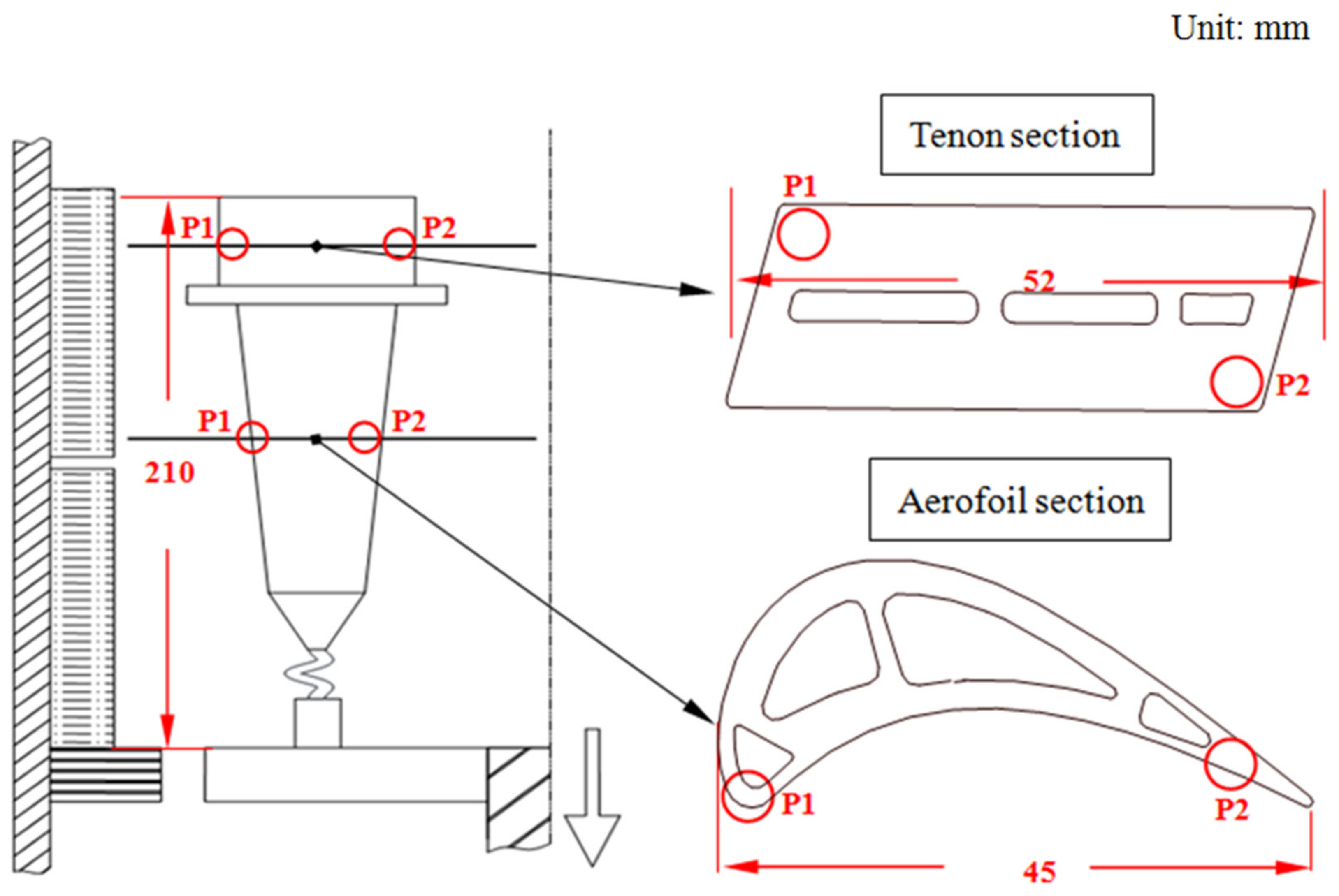



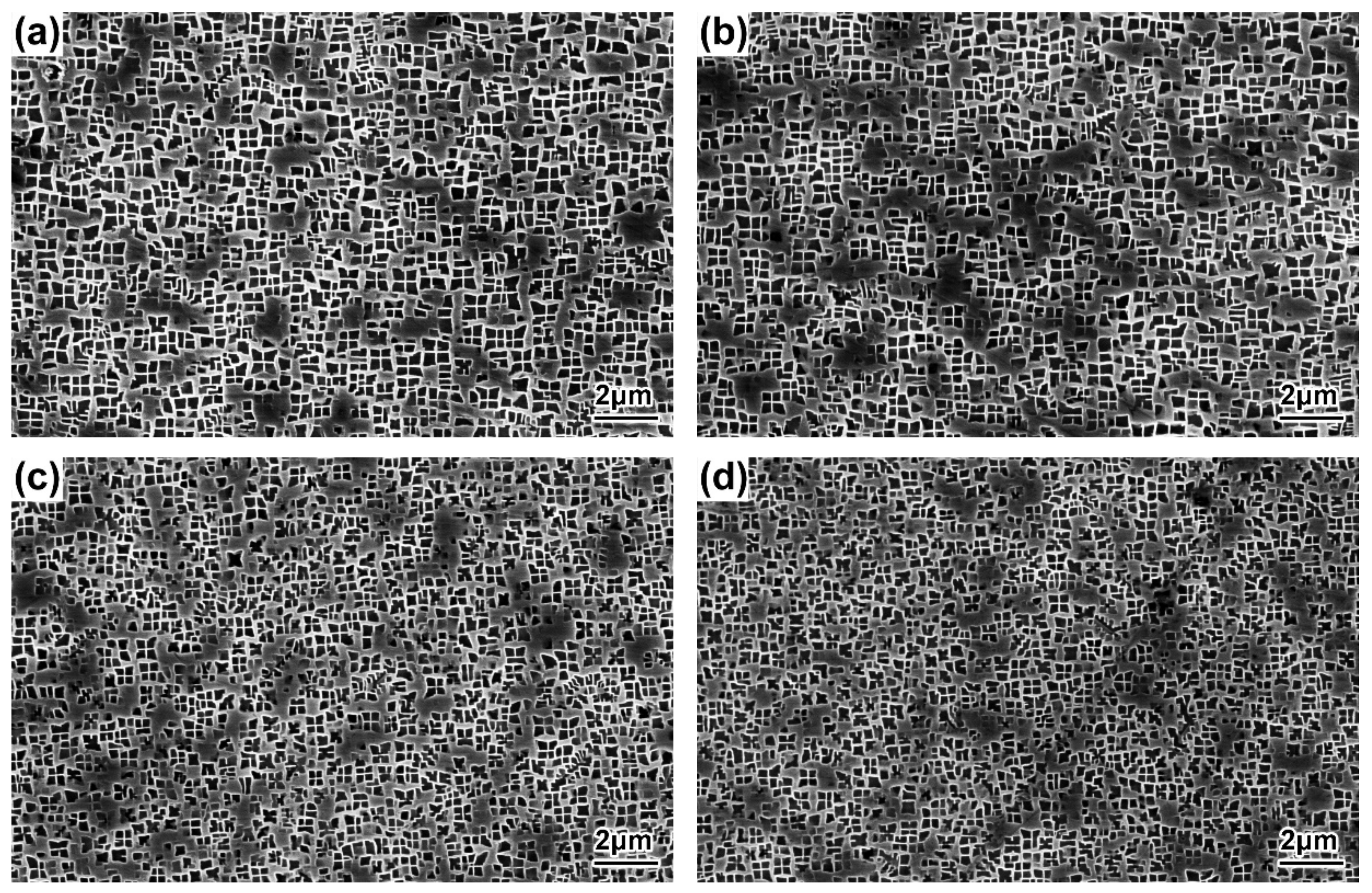
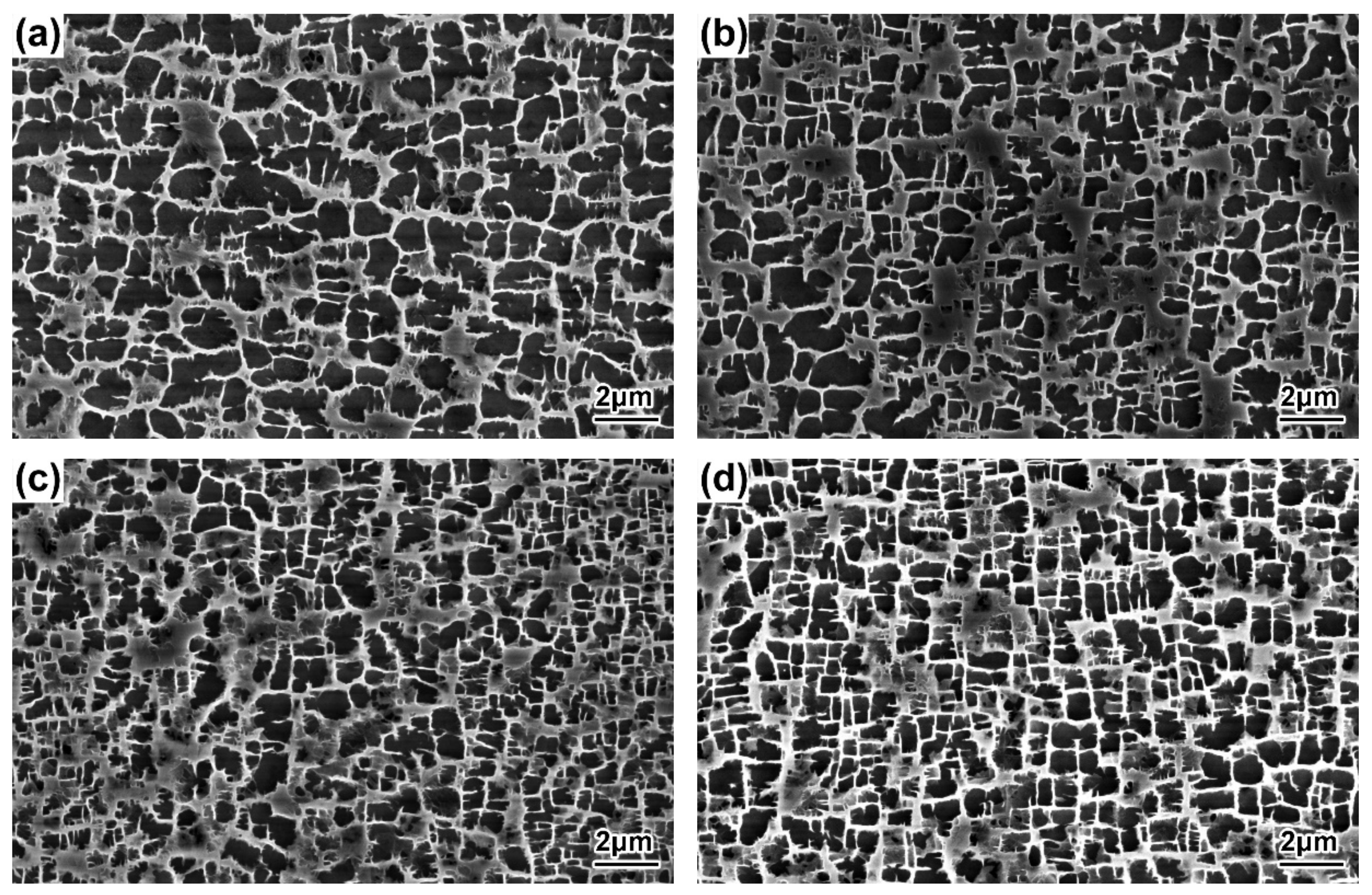
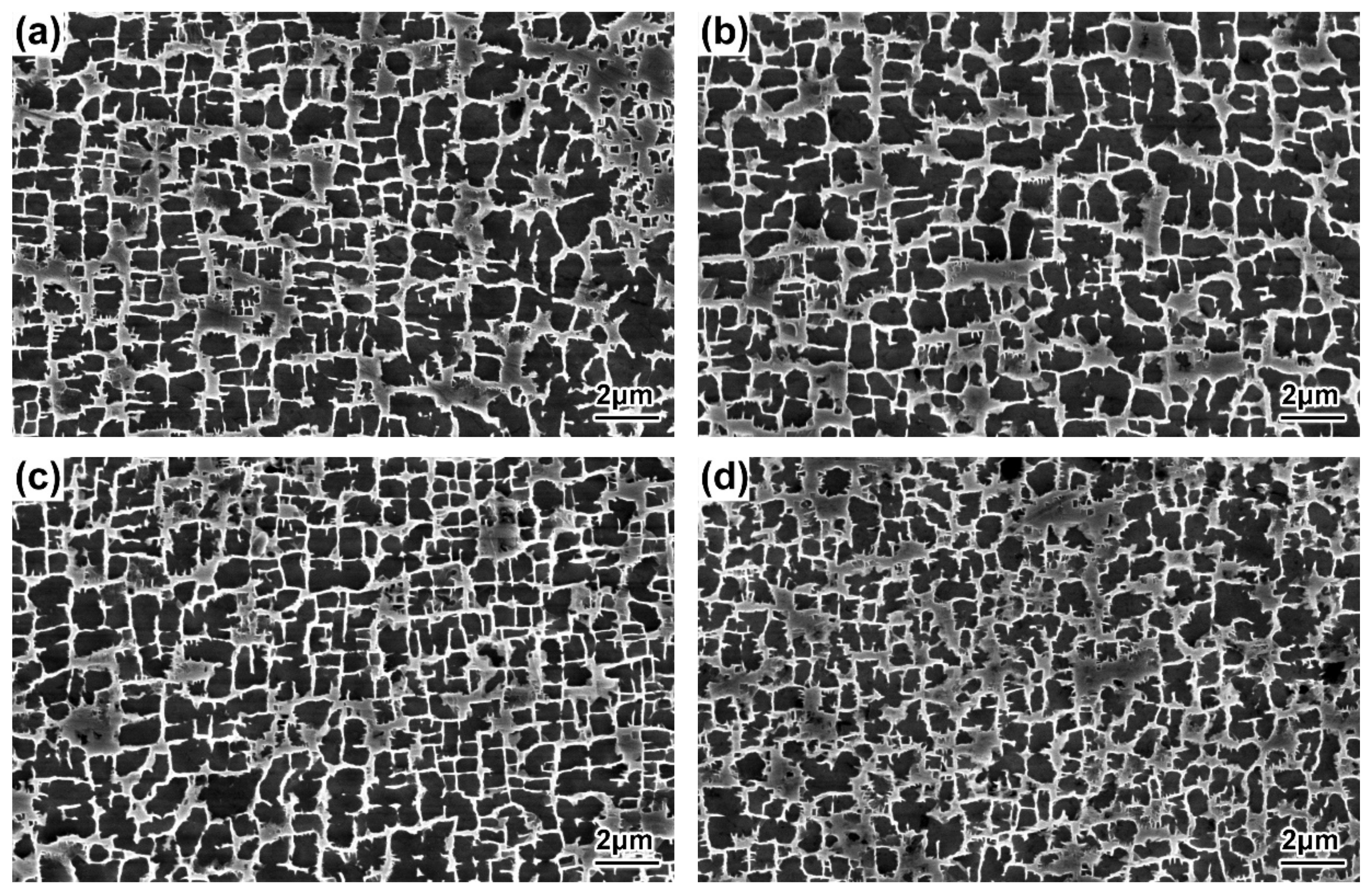
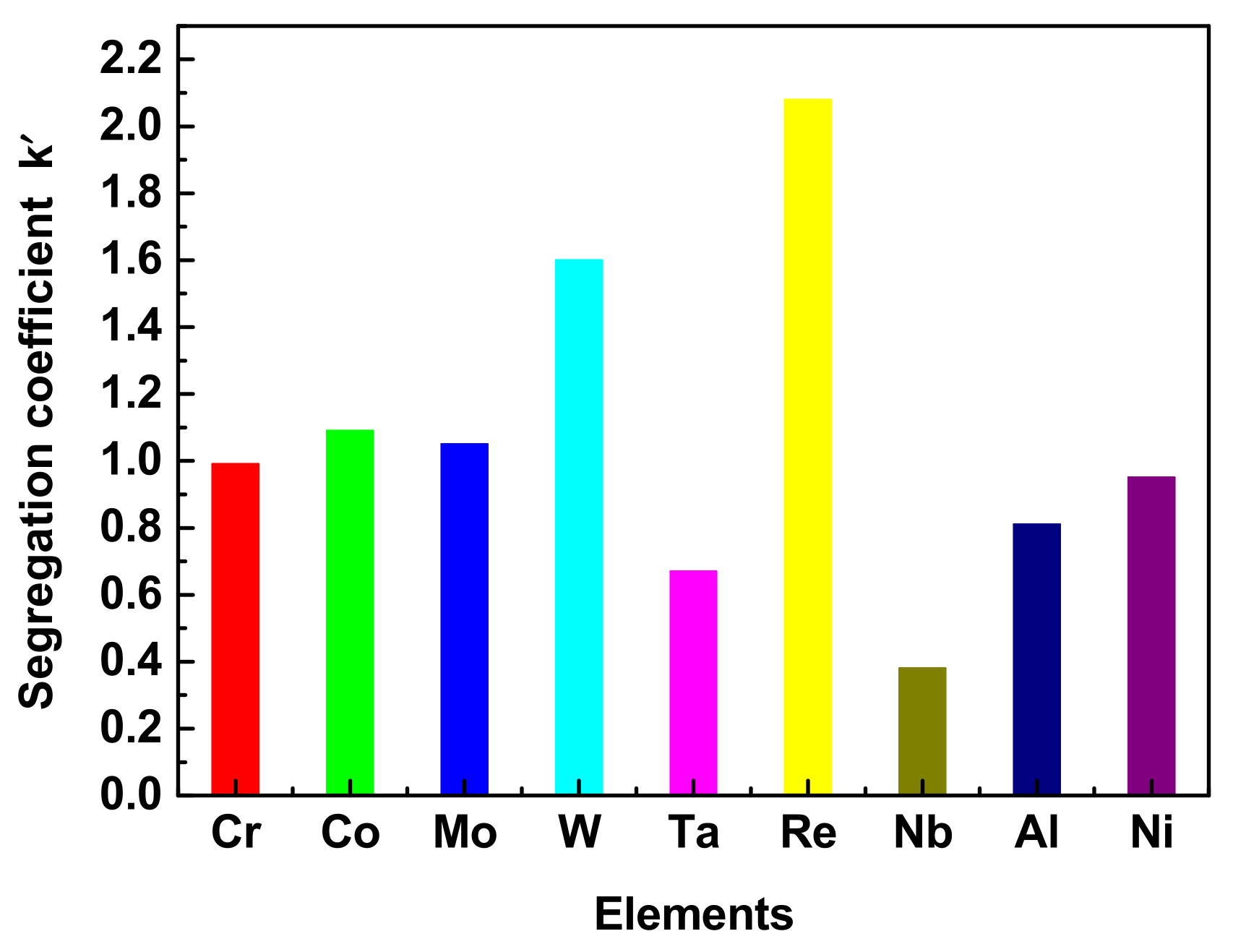
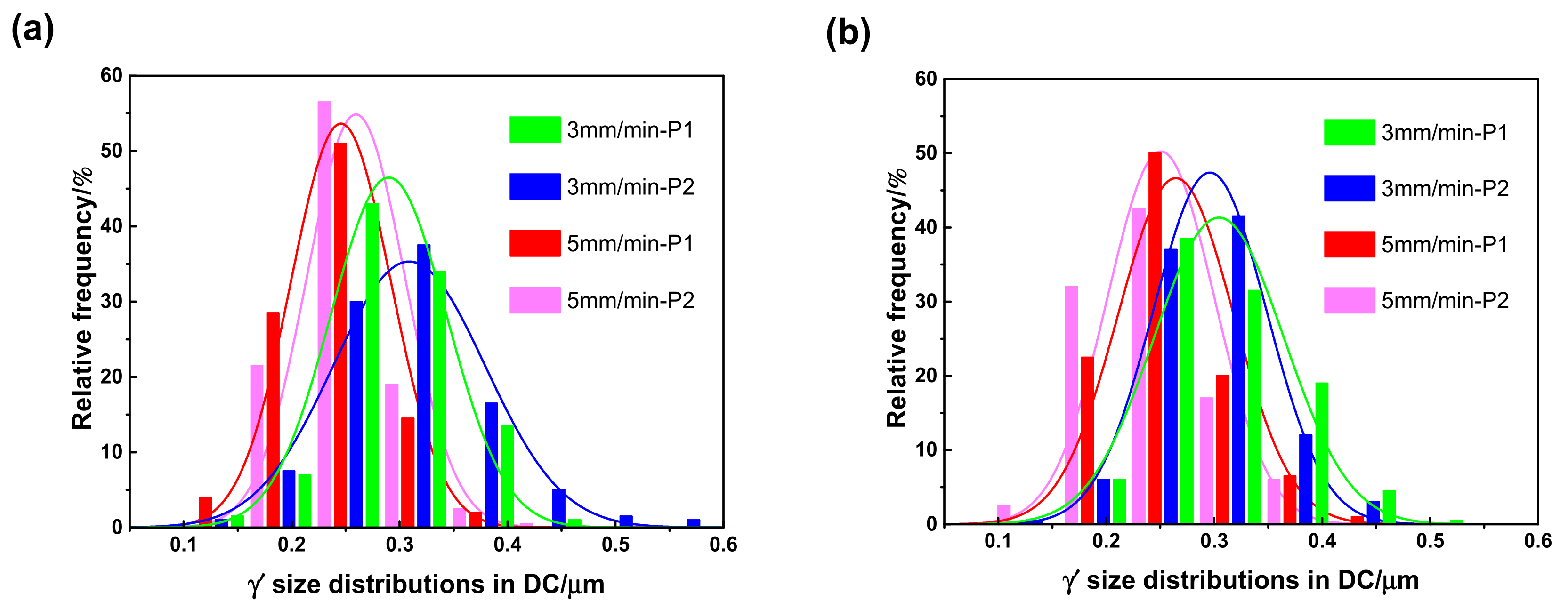
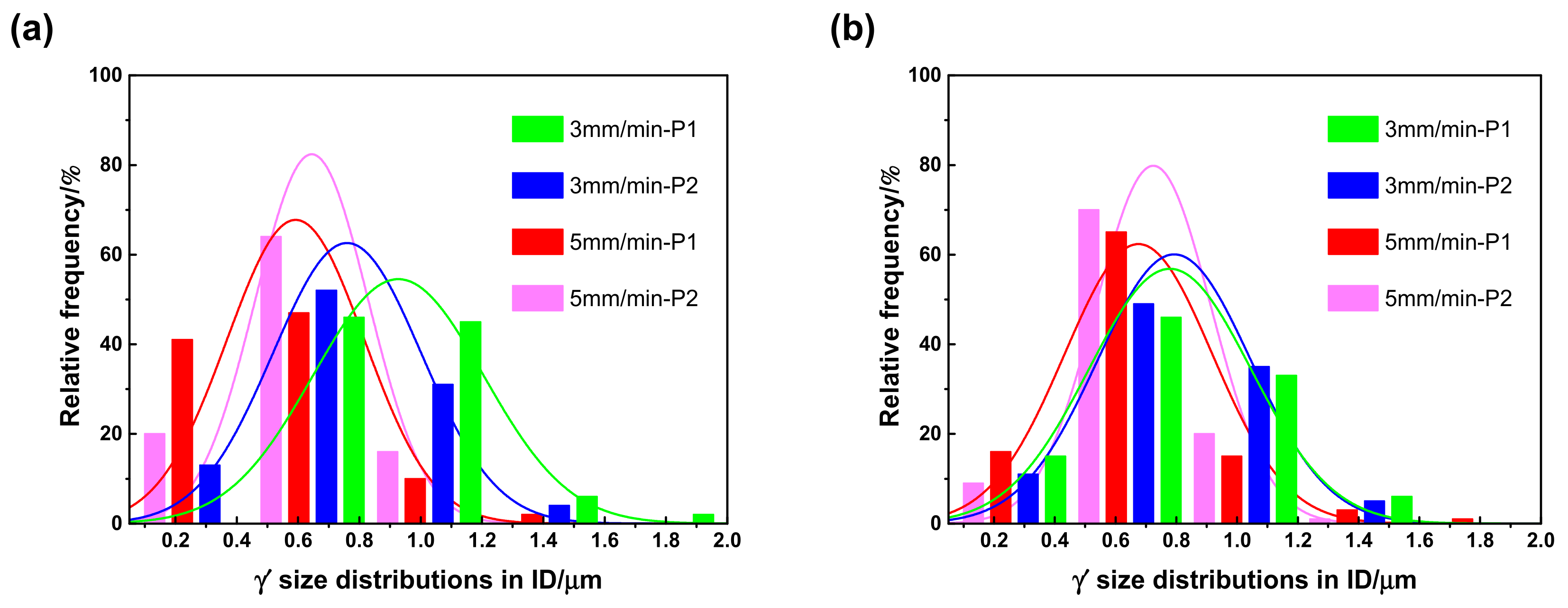





| Cr | Co | Mo | W | Ta | Re | Nb | Al | Hf | C | Y | Ni |
|---|---|---|---|---|---|---|---|---|---|---|---|
| 3.5 | 7 | 2 | 6.5 | 7.5 | 4.5 | 0.5 | 5.6 | 0.1 | 0.008 | 0.001 | Bal |
| Withdrawal Rate (mm/min) | Section | PDAS/mm |
|---|---|---|
| 3 | AS | 0.385 |
| 5 | AS | 0.377 |
| 3 | TS | 0.411 |
| 5 | TS | 0.405 |
| Withdrawal Rate (mm/min) | Section | Position | dmean (μm) | |
|---|---|---|---|---|
| DC | ID Regions | |||
| 3 | AS | P1 | 0.289 | 0.927 |
| 3 | AS | P2 | 0.309 | 0.760 |
| 5 | AS | P1 | 0.248 | 0.592 |
| 5 | AS | P2 | 0.259 | 0.645 |
| 3 | TS | P1 | 0.304 | 0.779 |
| 3 | TS | P2 | 0.296 | 0.793 |
| 5 | TS | P1 | 0.264 | 0.675 |
| 5 | TS | P2 | 0.251 | 0.725 |
| Withdrawal Rate Changed (mm/min) | Section | γ′ Size Changed (μm) |
|---|---|---|
| 3→5 | AS | 0.289→0.248 |
| TS | 0.304→0.264 |
| Cross-Sectional Area Changed (mm2) | Withdrawal Rate (mm/min) | γ′ Size Changed (μm) |
|---|---|---|
| TS: 830→AS: 180 | 3 | 0.304→0.289 |
| 5 | 0.264→0.248 |
Disclaimer/Publisher’s Note: The statements, opinions and data contained in all publications are solely those of the individual author(s) and contributor(s) and not of MDPI and/or the editor(s). MDPI and/or the editor(s) disclaim responsibility for any injury to people or property resulting from any ideas, methods, instructions or products referred to in the content. |
© 2023 by the authors. Licensee MDPI, Basel, Switzerland. This article is an open access article distributed under the terms and conditions of the Creative Commons Attribution (CC BY) license (https://creativecommons.org/licenses/by/4.0/).
Share and Cite
Xue, Y.; Wang, X.; Zhao, J.; Shi, Z.; Liu, S.; Li, J. Effect of Withdrawal Rate on Solidification Microstructures of DD9 Single Crystal Turbine Blade. Materials 2023, 16, 3409. https://doi.org/10.3390/ma16093409
Xue Y, Wang X, Zhao J, Shi Z, Liu S, Li J. Effect of Withdrawal Rate on Solidification Microstructures of DD9 Single Crystal Turbine Blade. Materials. 2023; 16(9):3409. https://doi.org/10.3390/ma16093409
Chicago/Turabian StyleXue, Yanpeng, Xiaoguang Wang, Jinqian Zhao, Zhenxue Shi, Shizhong Liu, and Jiarong Li. 2023. "Effect of Withdrawal Rate on Solidification Microstructures of DD9 Single Crystal Turbine Blade" Materials 16, no. 9: 3409. https://doi.org/10.3390/ma16093409




